-
Posts
5,391 -
Joined
-
Last visited
-
Days Won
3
Content Type
Profiles
Forums
Blogs
Gallery
Events
Store
Posts posted by Gordon Williamson
-
-
Yeah, he does look the type that would have been a bit of a disciplinarian with his students. :unsure:
0 -
Its his WW2 service of course which is of interest to me, as by then he is 50 years old and probably no longer up to front line service (he is medically discharged in 1944). He is assigned to the Wehrmachts Ordnungstruppe and serves with
3./Streifenkompanie XII
Zugwach-und Bahnhofswachkompanie XII
Wehrkreis-Überwachungs und Betreuungs-Abteilung XII, and
Kommandeur des Streifendienstes Wehrkreis XII
Wehrkreis XII was based in Wiesbaden so I guess he spent most his war there. First book I have seen with such a range of "Wache" type units.
 0
0 -
Unfortunately the entries for his active service are rather vague with references just of "Osten" and "Westen", and in WW2 from November 1939 he is on duty on the Home Front.
His EK2 would appear to relate to his time with Infanterie Regiment 97 "im Feld", serving on the Eastern FRont.
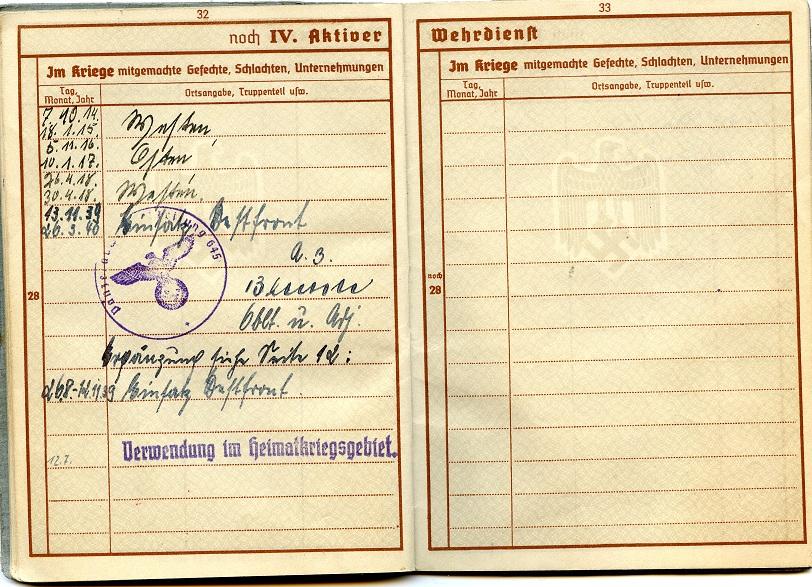 0
0 -
Although no Wound Badge is listed in his awards, he certainly saw combat and was wounded twice, in 1915 and 1918.
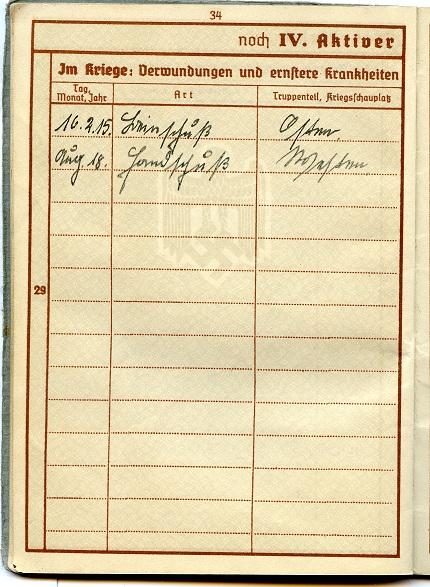 0
0 -
We see him as an Unteroffizier in July 1915, promoted Vizefeldwebel in October 1915 and commissioned as a Leutnant der Reserve in August 1917.
Confirmed as a Leutnant in the Wehrmacht in July 1938, promoted Oberleutnant in Jan 1942 and Hauptmann in August 1942
Only awards shown are the EK2 in 1916 and the Ehrenkreuz f. Frontkämpfer in 1935.
 0
0 -
....to a WW1 veteran Officer. Picked this one up thanks to a tip from Ian Jewison.
 0
0 -
Hi Peter
I haven't seen a Cross without Swords with the same flaws as the "with Swords" but they came from different tooling so that is to be expected.
I don't think any RK were found in the Deschler hoard, or at least I haven't heard of it.
Gordon...thanks!
Have you seen a cross w/o swords with the flaws showing on some of the crosses w/ swords?
...with stripped eyeholder...
And...was there any Rkkvk found in the so called "Deschler horde"? If so...with or without flaws?!
/Peter
0 -
The relative rarity of the KVK without Swords makes it difficult to be 100% sure but certainly on the original examples I have examined since noticing the small flaw on the Swastika, it has been present. With such a small number being made/awarded, I doubt if more than one set of tooling was made by each firm.
As for the flaws on the KVK with Swords, I believe these to be due to damage to the tooling so that the first striking would not have had the flaws. I have seen examples of the "with Swords" crosses which have all the characteristics of the Deschler tooling, but no flaws so I believe that the die strikings were initially clean and the flaws appeared later due to damage to the tooling - rather than there being multiple die sets, - flawed and unflawed.
0 -
Very nice Kevin. Good to see someone is still picking up some nice docs.
Re the Whirlwind, it would seem to me rather strange that he would just happen to claim a Whirlwind on the exact day that one was lost with supposedly (from the British point of view) no enemy action involved. I don't see how they can claim -
It is to be stressed that the two ME.109s had NOT followed the Whirlwinds and it seems certain that enemy action was not responsible for the disappearance of Sgt. Robinson. If the other pilot didn't see what happened to him how can they tell he wasn't taken out by your Me109 Pilot. Also, if the Me109s didnt follow them, how would they have known that the Whirlwind crashed and be able to claim a kill ?
The mostly likely scenario to me is that your Me109 pilot was indeed responsible, especially since at that early point in the war, the Luftwaffe seemed much more strict about recording "kills" and he would have required his wingman's confirmation.
His other Spitfire kill is more understandable if it is confirmed he did in fact hit and damage it. It wouldn't have been the first time, on either side, that an enemy aircraft seen to be hit and possibly in flames or belching smoke was assumed to have been destroyed and claimed as a kill but subsequently made it back.
Either way, great little set.
0 -
Fascinating stuff Erik !
Given the range of U-Boat types and that fact that even the smallest of them must have had hundreds of such labels and many many gauges and similar bits of equipment, there must have been a bewildering amount of material like this - most of it now of course at the bottom of the sea.
Its a great pity there aren't any reference works available on this kind of material.
0 -
It would be interesting to know what the cap band stiffener is made from.
In general however, it does not look very promising to me. That cross hatched effect # to the underside of the peak is generally indicative of postwar manufacture and as the peak does not appear to have been messed with or removed/replaced it casts doubt over the cap as a whole.
0 -
1. In my personal opinion it is wrong, to combine the word "award" with the 57s, it is misleading. I prefer 57 versions.
Uwe
Agree 100%. I think the problem is that many English speakers (including myself above - my error) wrongly use the word "Award" without thinking, as a generic term instead of "Medal" , "Badge" , "Decoration" etc. Of course if something was never awarded but only authorised to be worn and had to be privately purchased, it cannot in real terms be an "award".
0 -
Here is a very rare shot showing some of the very first groups of civil Gendarmerie who were attached to the Army to serve as Feldgendarmerie. This is how they appeared during the pre-war troop movements such as the occupation of Aautria, the Sudetenland etc and in the early stages of the Polish campaign.
Note the use of the basic Gendarmerie uniform but with the addition of the Heer breast eagle and the Feld-Gendarmerie armband covering the sleeve eagle. Army NCO braid has been sewn along the top edge and front of the collar ( which still retains the Gendarmerie collar tabs) and what at first might appear as silver flecked piping to the shoulder strap on the guy at left can been seen more clearly with the guy at far right, to be Army braid sewn over the top of the Gendarmerie strap. Genuine army straps were also used at times.

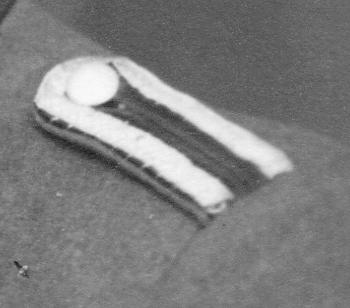 0
0 -
The question of "fake" 57 awards is one that could be argued endlessly. If the award meets the design requirements of the Ordens Gesetz then they are "57" "neue Form" awards.
However in collector terms, those which were factory made by one of those firms recognised as having made 57 awards , such as Steinhauer & Lück have a collector desirability than more modern pieces do not have. Some will classify any made in recent years by entrepreneurs for the collector market as "fakes". Technically however, if they meet the design requirements of the design they are not legally fakes.
In this case however, it looks like a casting made from a mould using a "proper" three piece struck example as a master.
As such I'd say it has virtually zero value or desirability.
0 -
Isn't "Condor Legion" - as it relates to wound badges - a misnomer?
Kinda. Germans wounded could receive the Spanish Wound Medal for Foreigners from the Spanish authorities, as well as the German Wound Badge from their own country.
The "new" Wound Badge with swastika was first introduced on 22 May 1939 specifically for those who had been wounded in Spain. It was further renewed on 1 September 1939 for WW2. In both cases the badge was identical ( described in both original orders as being "the same as for WW1" but with the addition of the swastika.) The photographs published with the new foundation order in September 1939 show what collectors refer to as the "Legion Condor" badge and not the standard WW2 type. Current thinking leans more towards all the types previously referred to as "Legion Condor", "Prototye 1939" and "Type I 1939" are simply all just "Type I" variants.
Of course attributing all Type I Wound Badges as "Legion Condor" simply allows dealers to charge a premium price for them, despite them being issued well into WW2 !
0 -
The pin-back type with plated over reverse is super. Definitely the most desirable version of the Type I 1939 Wound Badge. If you were only going to have one Type I, it would be this version. Excellent !
I have severe doubts over the identification of certain Type Is as "Condor Legion". To me, they are all simply "Type I" 1939 badges.
The original foundation decree for the 1939 badges states that they are "the same as that of the Army in World War One" but with the Swastika on the helmet, i.e. the so-called "Type I" badge.
I doubt very much whether they created a special design for the Condor Legion, then modified it slightly for the "Type I" introduced just four months later. I would say that they are all just manufacturer variants of the Type I.
Hamelmann's book was a great book in its day, but a forthcoming German book will take the study of German wound badges to a whole new level. I believe it classes theses early badges together as Type I variants.
0 -
This type of screwback is considered controversial by many Wound Badge collectors. Detlev once featured this style in one of his "Fake of the Week" features.
Can't recall whether they are said to be a copy of a known original style or whether the style itself is bad. I've seen images on another Forum (GCA)of two of these which appear to have come from different tooling so one miught be a fake mimicking the other which is real, or both could be fake. I don't think a definitive decision was reached.
0 -
Not a wound badge per se but I think of NoK awards as closely related as they were given to the families of those who had suffered the worst wounds of all - fatal ones.
One of my favourites, Finland's classy looking Cross of Mourning with its distinctive funereal black ribbon.
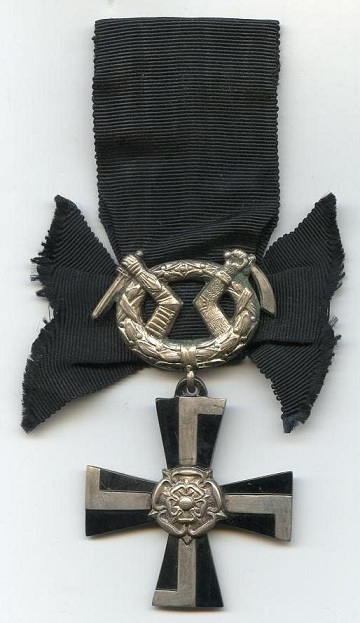 0
0 -
Justin,
You only need the Mosel to complete your U-Boat set, there were no ribbons for the Kophamel, Bauer or Wünsche
0 -
Congratulations on acquiring an Emsmann. A very difficult ribbon to find.
We should really change the title of this thread as the word "Meagre" is long out of date !
0 -
Hello Marc,
Yes indeed it is still a rare and interesting piece !
Both Feldgendarmerie and Feldjäger troops continued to be used by the Allies for some months after the war ended. Feldjäger were mostly in the American zone with Feldgendarmerie in both the British and American zones. I'm sure many allied troops were surprised to see armed Feldgendarmerie controlling traffic. You can see how the two British troops in the armoured car in the photo above are looking back at the German MPs. Probably thinking "What the F....!"
0 -
Hello Marc,
I have one of these in my collection. I believe it dates from immediately after the war when many former members of the Military Police were employed by the British in the British sector of occupied Germany to control the many German soldiers who were being processed through the various discharge centres. It is a matter of record that the British Army (VIII Corps)had almost a full Regiment of former Feldgendarmen still employed by them
Here is my example
http://gmic.co.uk/index.php/topic/30252-british-feldgendarmerie/
I have also seen them referred to as for German Military Police on the Channel Islands during WW2 but I think that is not correct.
Here are some German MPs directing British traffic after the end of the war ( note they are still armed !)
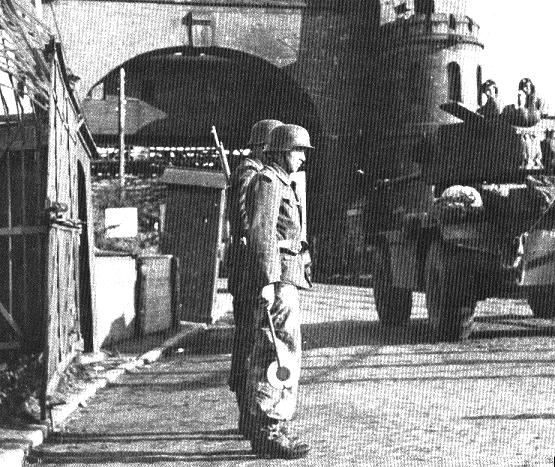 0
0 -
Three very nice badges indeed. The Juncker and Mayer are especially fine.
0 -
Hi Justin
No, I certainly don't think that all of this type are fake. Helmut Weitze has one in Zinc with most of the finish missing that has this type of fitting and is surely a good late-war original. No doubt that this type of fitting was also used on other stuff during the period.
However, there is no question that fakes in this exact configuration were certainly made and this style of pin is still widely used on fakes. I saw a Luftwaffe summer tunic metal breast eagle recently with a pin just like this recently which was a howling fake.
If I was looking to obtain just one such breast eagle as an example, I would avoid this type as the 1970s fakes are too close the the originals for comfort. They are not exactly rare so its not difficult to find a "one-looker" original. I haven't ever seen good fakes with the correct barrel or block type hinge however so would consider them safe (for now).
 0
0




Kriegsmarine Cap Emblems
in Germany: Third Reich: Wehrmacht Medals, Decorations & Awards
Posted
Thereby lies the problem with these crew badges. It is virtually impossible to prove originality and in most cases you end up having to go with "gut feeling". The Seahorse for example though, certainly has that look of real wear and age about it and, to me, certainly has nothing about it to suggest it is anything other than good.
As to the badge offered by Thomas Huss, that looks good to me also. Bear in mind that although the "on board" made badges are always rather crude, the enamelled badges were usually contracted out to local badge makers and were almost always of very fine quality.
I recall the box full of original enamel Sawfish badges that were discovered in the stores of a badge maker in France some years back, perfect little pieces and of superior quality. They were donated as a gift to the U-Boot Archiv.